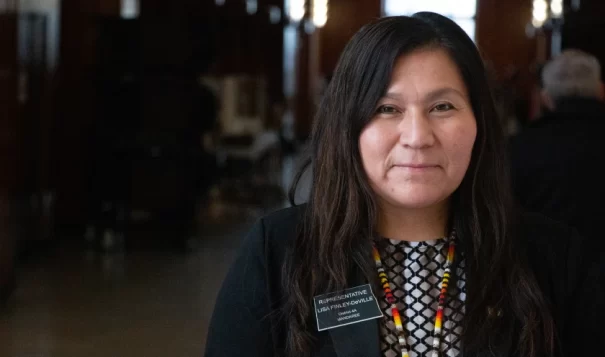Opinion Advocates for ideas and draws conclusions based on the author/producer’s interpretation of facts and data.
North Dakota House Concurrent Resolution 3027
 North Dakota Rep. Lisa Finley-DeVille, D-Mandaree, poses for a portrait in Memorial Hall at the state Capitol in Bismarck on Tuesday, Dec. 6, 2022.Jeremy Turley / Forum News Service
North Dakota Rep. Lisa Finley-DeVille, D-Mandaree, poses for a portrait in Memorial Hall at the state Capitol in Bismarck on Tuesday, Dec. 6, 2022.Jeremy Turley / Forum News Service
A concurrent resolution directing the Legislative Management to consider studying, in consultation with the Department of Transportation, needed safety improvements to State Highway 22 at junctions Bureau of Indian Affairs 12, 30, and 14, State Highway 23 within the exterior boundaries of the Fort Berthold Reservation, State Highway 73 West before the Fort Berthold Reservation line, and State Highway 37; and the feasibility and desirability of reducing the speed limit on State Highways 22 and 23 to 55 miles per hour.
I sponsored HCR 3027 to create a study that would focus on the oil traffic patterns around Fort Berthold Reservation. Since 2009 oil and gas development has continued to grow, and oil wells on Fort Berthold Reservation currently produce approximately 141,000 barrels of oil per day. That is a lot of oil that needs to be transported, resulting in more trucks on the road that transport everything from oil, waste products, water, and other materials that are used and produced on the well pad.
Fort Berthold Reservation has greatly benefited from the oil and gas development, but living with a busy industry does have serious implications for the communities. Especially for motorists that travel alongside oil field traffic. All residents that utilize the highway system in and around Fort Berthold Reservation would have benefitted from a study on creating safety corridors on State Highway 22 at junctions Bureau of Indian Affairs 12, 30, and 14, State Highway 23, State Highway 73, and State Highway 37.
Understanding the impact of traffic patterns and how truck traffic affects communities is important in keeping Mandaree residents safe when they leave the safety of their homes. Highway safety corridors are designated stretches of roadways that have a higher incidence of accidents, fatalities, and injuries. These corridors would have been marked with signs and have increased enforcement measures to ensure that drivers adhere to the posted speed limits, use proper signaling, and follow all other traffic laws.
The need for highway safety corridors, especially in the identified areas near and on Fort Berthold Reservation, is needed because of the alarming statistics of road accidents. The North Dakota Department of Transportation Highway Safety Division report shows that in North Dakota, from 2019-2021, there have been 272 fatal car crashes. In the United States, nearly 40,000 people die every year in road accidents, and thousands more suffer from severe injuries. The economic cost of these accidents is also staggering, costing billions of dollars in medical bills, property damage, and lost wages.
The stories of close call collisions that have been shared with me include school buses being nearly impacted by oil field trucks that fail to stop at posted stop signs, emergency first responders forced to give way to large trucks on their way to calls that are life-threatening, and other stories of families that have experienced dangerous situations and tragic highway fatalities while on the road.
Highway safety corridors where oil field traffic is unavoidable are critical in addressing this problem. This study would have provided a focused approach to identifying and mitigating the factors that cause accidents on our roads. One positive outcome would have included engineering improvements, such as the installation of rumble strips, roundabout turns, improved lighting, and reflective signage. Measures taken in the state of Colorado saw a significant decrease in accidents and fatalities on designated safety corridors after implementing several safety measures, including increased enforcement and education campaigns. But highway safety corridors are not just about reducing accidents and fatalities. They are also about ensuring that our communities are safe, livable, and sustainable. They support economic development by reducing the cost of accidents and improving the overall quality of life for people who use our roads every day.
After conversations about highway close calls and tragic fatalities with the North Dakota Department of Transportation, I am pleased to see the installation of highway roundabouts near Mandaree, at the junction of Highway 22 and Highway 73, and near New Town at the junction of Highway 23 and Highway 8. Roundabouts are designed to reduce the severity and frequency of accidents by requiring vehicles to slow down as they navigate the circular path and significantly lower the risk of high-speed, T-bone collisions common in conventional intersections.
Additionally, the absence of traffic signals or stop signs eliminates the possibility of red-light running accidents. My hope is for ND DOT to beautify these roundabouts with Mandan, Hidatsa, and Arikara tribal designs.
I hope that the creation of these new traffic patterns will create a safer highway for us all.
